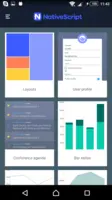Overview
What is NativeScript?
NativeScript is an open source framework that allows you to create native iOS and Android apps, with one codebase, using the web skills you already have (JavaScript and CSS) and the libraries you already love.
Disappointment in NativeScript for production
The unknown beast - NativeScript
NativeScript -- Not Yet Ready for Large Development Efforts
Climb to NativeScript, enjoy the Vue...
Mobile apps delivered by leveraging our existing skillset with NativeScript
NativeScript makes cross-platform mobile app development easy, fast, and efficient.
The best possible way to develop your next Android and iOS application.
NativeScript - Mobile App Development on Steroids
Mobile Performance with NativeScript
NativeScript, the fast way to build robust mobile applications
The Brad Martin Perspective
NativeScript: Good for mobile performance.
NativeScript - Cross platform app development for n00bs
Awards
Products that are considered exceptional by their customers based on a variety of criteria win TrustRadius awards. Learn more about the types of TrustRadius awards to make the best purchase decision. More about TrustRadius Awards
Pricing
What is NativeScript?
NativeScript is an open source framework that allows you to create native iOS and Android apps, with one codebase, using the web skills you already have (JavaScript and CSS) and the libraries you already love.
Entry-level set up fee?
- No setup fee
Offerings
- Free Trial
- Free/Freemium Version
- Premium Consulting/Integration Services
Would you like us to let the vendor know that you want pricing?
1 person also want pricing
Alternatives Pricing
What is Quickbase?
Quickbase helps users tackle any project, no matter how complex. Quickbase helps customers see, connect and control complex projects. Whether it’s raising a skyscraper or coordinating vaccine rollouts, the no-code software platform allows business users to custom fit solutions to the way they work…
What is OutSystems?
The OutSystems Platform is a Platform-as-a-Service solution for rapid delivery of responsive web and mobile applications. It includes functionalities required to develop, deploy, manage and change web and mobile applications. It is targeted at the delivery of enterprise applications that require…
Product Demos
NativeScript Realtime Development
How to Build Apps with NativeScript
7 - Optimizing the Startup time of NativeScript Angular Apps
NativeScript & WordPress REST API Demo LiveSync
How to Build Enterprise Apps with Kinvey & NativeScript Demo
Optimizing startup time of NativeScript Angular apps
Product Details
- About
- Competitors
- Tech Details
- Downloadables
What is NativeScript?
NativeScript Features
- Supported: Reuse web skills (JavaScript, CSS) to create truly native mobile apps for iOS and Android
- Supported: Deep integration with popular JavaScript frameworks like Angular or Vue to minimize learning curve
- Supported: Extensive code sharing between mobile platforms (including UI) and web apps (when used with Angular)
- Supported: Deliver high-quality mobile apps to multiple platforms faster, using web developers you already have
NativeScript Screenshots
NativeScript Video
NativeScript Competitors
- Xamarin
- ReactNative
- Ionic/Hybrid
NativeScript Technical Details
| Deployment Types | On-premise |
|---|---|
| Operating Systems | Windows, Linux, Mac |
| Mobile Application | Apple iOS, Android |
Comparisons
Compare with
Reviews and Ratings
(18)Community Insights
- Business Problems Solved
- Pros
- Cons
- Recommendations
NativeScript has proven to be an invaluable tool for developers across various industries. For a fitness startup, NativeScript enabled them to launch their app in just six months, providing a fast and efficient solution for their mobile development needs. Another company in the e-learning education industry is testing NativeScript as a potential alternative to their current app built on Ionic v1, with the goal of achieving an offline-first experience and improved performance.
Customers in the customer service industry have found NativeScript to be particularly useful due to its compatibility with the Angular web framework. This has allowed them to implement mobile and web-based cross-platform applications seamlessly, leveraging their existing knowledge and skills. Additionally, NativeScript's access to system APIs and seamless integration with third-party libraries has empowered developers to have full control over platform-specific functionalities, enabling them to build robust and feature-rich applications.
Countless developers have also turned to NativeScript for its ability to reuse existing frameworks and achieve native performance. It has been successfully used by consulting companies looking for a mobile app development platform that offers native performance, native UI generation, and ease of cross-platform development. These companies have praised NativeScript for allowing them to leverage their existing skills in Angular, TypeScript, and CSS, resulting in faster development cycles and cost savings.
Notably, NativeScript's versatility has made it an excellent fit for organizations that need to develop mobile applications for different platforms. By avoiding the need for separate codebases, they can save significant time and effort while still achieving native performance on both iOS and Android. This has made NativeScript a go-to choice for many developers working on projects at various stages of development.
Overall, NativeScript has garnered positive feedback from its users who appreciate its compatibility with modern web frameworks like Angular, its access to system APIs, and its ability to achieve native performance while maintaining cross-platform capabilities. It is clear that NativeScript offers a powerful solution for mobile app development needs across diverse industries.
Extensive repository of plugins: Many users appreciate the extensive repository of plugins available in NativeScript, which allows them to enhance their development speed. This feature has been praised by numerous reviewers as it enables developers to quickly add functionality to their apps without having to build everything from scratch.
Flexibility of architectural choices: The flexibility of NativeScript's four architectural choices - JavaScript, TypeScript, Angular, and Vue - is highly valued by users. This flexibility has been mentioned by a significant number of reviewers who appreciate being able to choose the framework they are most comfortable with and easily transition from prototype to final product.
Native API access and performance: The fact that NativeScript offers 100-day zero Native API access is seen as a major advantage by many users. Multiple reviewers mention this feature as it allows them to leverage the full power of native UI and achieve better performance compared to other frameworks like Ionic or PhoneGap. This capability gives developers more flexibility and control over their app's performance.
Lack of ready-made UI collections: Several users have expressed frustration with the absence of ready-made UI collections in NativeScript. This means that users have to build their applications using default UI elements and then manually style them, which can be time-consuming and require additional effort. Users feel that this limitation hampers the ease and convenience of designing user interfaces for their applications.
Default UI elements not intuitive or user-friendly: Some users have found NativeScript's default UI elements to be less intuitive or user-friendly than they would prefer. This has made it more challenging for them to quickly and efficiently create applications. They believe that a more intuitive interface would greatly enhance the development process.
Lack of built-in support for customizing UI elements: Another concern raised by users is the lack of built-in support or guidance for customizing UI elements in NativeScript. Users feel that they could benefit from more assistance or resources in this area, as it would make customization easier and faster. They believe that having readily available options for customizing UI elements would greatly improve their experience with the software.
Users have provided several recommendations for Native Script based on their experiences. Based on the feedback, the following are the three most common recommendations:
-
It is advisable to do a few tutorials and check if the desired functionality is supported through plugins or if the user is willing to create them. This implies that there may be cases where certain features are missing in the software, and users should be prepared to address this by exploring plugins or creating their own.
-
Users recommend trying Native Script to learn something new and explore interesting features. This suggests that Native Script offers a unique learning experience for those interested in expanding their skills and discovering new capabilities.
-
However, users do not recommend using Native Script for production-ready applications. While the software has its merits, it may not be suitable for developing applications intended for deployment in a live production environment.
These recommendations highlight the importance of familiarizing oneself with Native Script's capabilities through tutorials, being open to exploring plugins or creating custom functionality, and considering the software's limitations when deciding whether it is appropriate for specific use cases.
Attribute Ratings
Reviews
(1-2 of 2)- Executes really fast compared to other alternatives
- Compiles down to native code and runs as a native app
- Provides a way to split custom content, including CSS styles, into separate files per target platform
- The ABSOLUTE WORST documentation I have ever seen for an environment which advertises direct involvement with Google and other vendors. Their website content appears to be written once as a version comes out, and then is never updated again as follow-on versions with significant changes are released.
- Examples provided are often written from an expert's view, making far too many assumptions, and containing too much outdated content, to be useful to any developer who is just learning the environment.
- Some areas of considerable interest, such as the development of composite plugins (draw on the use of existing components as opposed to new native components), are void of ANY useful support.
- Support is left up to the use of stackoverflow.com questions and answers, and several of those who respond frequently, do so with language which comes across in an arrogant manner, and only serves to help in a specific instance, not in a global manner which would be useful to all.
- The description of the environment is misleading. One is often led to believe that use of NativeScript will significantly reduce development effort and time. I would venture to guess that in most cases, this is untrue. A lot of effort is spent trying to keep the web app and the mobile apps at the same level of development, because the NativeScript components DO NOT support web pages. The user interface of a web app is still almost entirely new development.
- The appearance of an Android mobile app is only like that of an iOS mobile app about 90% of the time. You cannot develop an app in NativeScript for an Android device, and expect it to look the same for iOS apps. Organizations who read about NativeScript, are misled into believing that the will be able to reduce staff by eliminating all Android developers or all iOS developers. To do so, is unwise, and in most cases, I believe that organizations will find it easier to develop for one mobile platform and then have the other mobile platform follow one version behind.
- NativeScript advertises that it provides great support for Angular and other environments. While I cannot speak directly to those other environments, I can say that the integration between NativeScript and Angular is CLUNKY and PROBLEMATIC! What is easily accomplished in Angular, is a headache in NativeScript, and ends up degrading the quality of use within Angular. For example, Angular allows for developers to very easily develop components which reduce code duplication. Developing a NativeScript UI plugin (aka composite plugin) is made so difficult through the abundance of BAD information on the NativeScript website and manual operations to get it to work within Angular, that it defeats the purpose of building them. I see developers spending more time trying to fix the integration of a UI plugin than they spend in actually using the plugin.
If you are looking to add the use of NativeScript to an existing environment, give your developers several months to work through several significant scenarios individually in full-fledged (not stubbed) proofs-of-concept. Impress upon those developers, the need to delve deep into the construction of NativeScript UI plugins which require interaction with other areas of functionality within the environment. Even if you believe that the out-of-the-box functionality of NativeScript appears sufficient, ask each of your developers to attempt the development of a couple of NativeScript plugins which interact with the native functionality of both Android and iOS.
Once your development has had ample (or excessive) time to provide you with working proofs-of-concept, please listen intently to all of the concerns posed by those developers. Do not accept a summary report of their efforts. I cannot stress this last one enough, because this is often when large development teams fail, and/or end up going way over budget.
- The poor quality of NativeScript documentation has the potential to weigh heavily on development timelines, budgets, and QA resources in a NEGATIVE manner.
- The poor interoperability of NativeScript plugins can significantly increase development time.
- The need to seek out professional instruction to learn how to use NativeScript effectively may become a burden on your budget.
- The number of breaking changes between versions of NativeScript, may cause your development efforts to lag further behind the most recent releases of NativeScript and your other chosen environments than you are accustomed to.
- NativeScript still does not support the latest major version of Angular. Any significant changes to the other environment components of your systems may hold you back even further while NativeScript plays catch-up.
NativeScript - Mobile App Development on Steroids
- NativeScript has a large repository of plugins at market.nativescript.org for the times when you want to boost your development speed.
- NativeScript gives you 100% day zero Native API access.
- NativeScript doesn't use any webview to render the UI. So you get Native UI, and therefore better performance, when compared to things like ionic or phone gap.
- With NativeScript you get 4 architectural choices, JavaScript, TypeScript, Angular and Vue. Choose the one you are comfortable with.
- Nativescript runs everything on a single thread. i.e., the UI thread. If you want to offload some processing, you have to use web workers. This experience can be improved in the future releases.
- Currently NativeScript only have hot reload when you change the UI file or Css file. There is no hot reload when you change Js/Ts file, unlike Google's Flutter. This is also something which NativeScript will get in the future releases.
- In current version of NativeScript, there is no livesync when building with webpack. This feature will be added with NativeScript 4.x. (an RC version for 4.x is already available)
- With NativeScript we were able to goto market sooner than what we expected. We were in market in just 6 months.
- Customers are happy with our products, in just a month, we reached 200 active users for AnyGo user app, and 17 active partners for AnyGo Partner app.
- We were able to build all the features that the business requires, using NativeScript. We even built some new plugins for this app. Example nativescript-paytm for payment gateway integration.
- React Native and Xamarin








